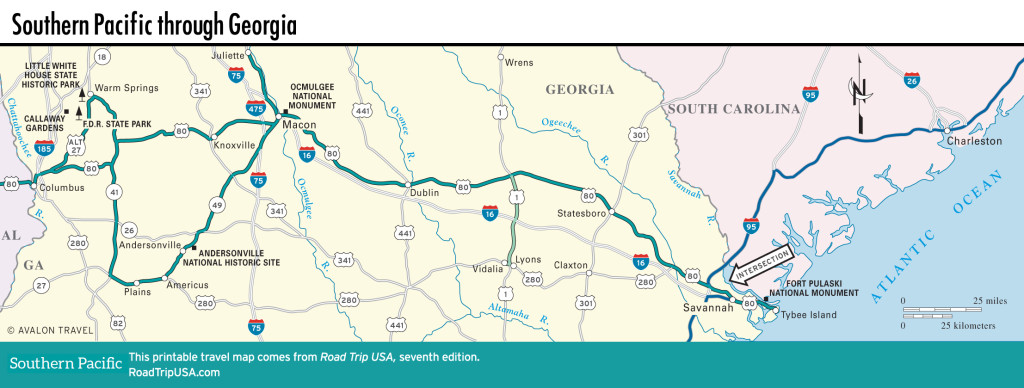Plains and Andersonville Prison
Plains: Jimmy Carter
Another stop along central Georgia’s “Presidential Trail,” 53 mi (85 km) southeast of Columbus via US-280, Plains (pop. 721), the home of former president Jimmy Carter, stands as a living monument to small-town America. Here, in a town that’s small and remote even by South Georgia standards, the 39th president of the United States was raised, mounted his presidential campaign, and now officiates on matters of international diplomacy—that is, when he isn’t teaching Sunday School at the Maranatha Baptist Church. Though the Carter family compound is off-limits, visitors can see Carter’s high school, stop by late brother Billy’s old gas station (the only one in town), and buy a bag of peanuts at the general store.
Much of Plains has been proclaimed the Jimmy Carter National Historic Site, and self-guided touring maps are available at the visitors center (300 N. Bond St., 229/824-4104, daily), inside the old Plains High School. Another major part of the Plains experience is the family farm, preserved in the pre-electricity circa-1937 state described in Carter’s evocative memoir, An Hour Before Daylight: Memories of a Rural Boyhood. Finally, there’s the old train depot downtown, which served as Carter’s campaign headquarters in 1976 and again in 1980, when he was trounced by Ronald Reagan.
The market town of Americus (pop. 15,309) is 11 mi (17.7 km) northeast of Plains. The wealth generated by the region’s cotton plantations is embodied in the towering brick Windsor Hotel (125 W. Lamar St., 229/924-1555, $85 and up). A truly elegant Victorian-era hotel with a three-story atrium lobby—one of the grandest interior spaces in the state—the Windsor is worth a look and makes a great base for exploring central Georgia.
Andersonville Prison
A dozen mi (19.3 km) northeast of Americus via Hwy-49, the Andersonville National Historic Site (229/924-0343, daily, free) stands on the site of the largest and most notorious Confederate military prison. During the 14 months the prison existed, 45,000 Union soldiers were imprisoned here in overcrowded conditions, and 13,000 died as a result of disease, poor sanitation, and exposure. Once this was uncovered, public outrage was so great that the camp’s commandant, Captain Henry Wirz, the only Confederate officer tried for war crimes, was convicted of murder and hanged in Washington DC. Historians generally agree that there was little he could have done to alleviate the suffering. Thousands of closely packed gravestones fill the Andersonville National Cemetery, just north of the prison site.
Only a few parts of the prison have been reconstructed, but the prisoners’ harrowing stories are told in one part of the adjacent National Prisoner of War Museum, which was dedicated in 1998 and recounts the stories of American POWs during wars up through the present day. Perhaps surprisingly, the tone of the museum is neither vindictive nor especially patriotic, focusing instead on the instances of individual bravery in the face of impossible difficulties.
Map of the Southern Pacific Route through Georgia
















